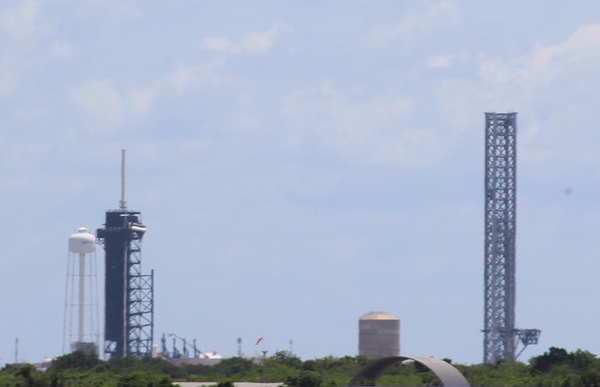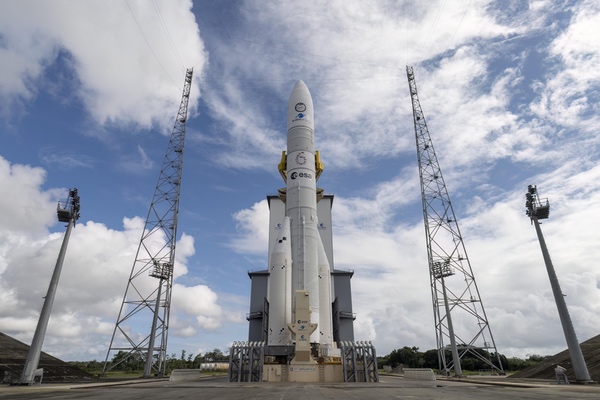Coping with Starshipby Jeff Foust
|
| “From my point of view, Ariane 6 has already demonstrated its competitiveness with 30 launches in the order book,” said Arianespace’s Arnoux. |
The same opinions are shared about other rockets that either have finally started launching or are nearing the pad. And those views are exacerbated by what is on the horizon: SpaceX’s Starship. That rocket, which made its fourth test flight last month, is edging closer to achieving orbit, offering the potential for delivering huge amounts of payload to low Earth orbit for very low prices per unit mass. If SpaceX is able to follow through on those goals, it would presumably be a backbreaker for the commercial business cases of other rockets.
Some of the companies competing against SpaceX in the launch market are taking a two-prong approach to dealing with Starship. One is to effectively ignore it in the near term, concluding that it serves different markets than their own rockets. But they also can’t ignore other aspects of the vehicle, such as its potential to disrupt their own launch operations.
“Competing pretty well”
At a briefing June 25 about the upcoming Ariane 6 debut launch, officials with the European Space Agency, prime contractor ArianeGroup, and launch services provider Arianespace said they were confident in the business case for their rocket. They noted it has orders for 30 launches, including 18 for Project Kuiper.
“From my point of view, Ariane 6 has already demonstrated its competitiveness with 30 launches in the order book,” Caroline Arnoux, head of the Ariane 6 program at Arianespace. “We have clearly demonstrated that we can serve the market and that Ariane 6 answers the market need.”
The briefing did not directly compare Ariane 6 to Falcon 9 or Starship, but at the end of the briefing one reporter asked about comments SpaceX’s Elon Musk has made that there is “no future” for rockets that are not reusable. “We can all have our own opinions. They only belong to the individuals,” responded Lucía Linares, head of space transportation strategy and institutional launches at ESA.
She again referred to “an order book that is full” for the next few years from government and commercial. “Ariane 6 is an answer to their needs. We’ll go through the inaugural launch, we’ll serve those customers, and we will continue to innovate.”
Another Arianespace official, speaking at a Washington Space Business Roundtable luncheon panel the same day as the Ariane 6 briefing, took on competition—or lack thereof—with Starship. “Their first coming three to four years, their primary mission for Starship is going to be to launch the Starlink constellation, number one, and number two is the NASA lunar ambition program,” said Steven Rutgers, chief commercial officer at Arianespace, referring to Starship’s role as the human lunar lander for the Artemis lunar exploration campaign.
He said that, after those first few years of focusing on Artemis and Starlink, SpaceX will offer Starship for other customers at a low price per kilogram. “But we feel confident that our customer segments that we’re focusing on will continue to work with us and invest in launches with Arianespace for many, many years to come.”
| “We’re differentiated in capability in our marketplace, and we overlap in the middle,” Bruno argued. |
Two other companies on the panel shared similar views, regarding Starship as less of a direct competitor with their vehicles than one might think. “Starship is really good at getting a large mass to LEO,” said Clint Hunt, director of intelligence and defense programs at United Launch Alliance (ULA), noting that Starship’s concept of operations required refueling to go to higher orbits or to the Moon. “If you want to go do direct inject to GEO, there may be a better option for you than Starship.”
Andy Bunker, vice president of government operations and business strategy at Rocket Lab, offered a similar view. “We’ve run into this before. Falcon 9, when it came on the scene, was meant to drive ULA out of business, and ULA is still here,” he said.
“Transporter and Bandwagon exist to drive Rocket Lab out of business,” he added, referring to SpaceX’s rideshare launch programs, “and Electrons have never been selling faster.”
“Some people view Starship as putting the three of us out of business,” Hunt concluded. “I’m not sure that’s the right context.”
Hunt’s boss agrees. “We’re competing pretty well,” Tory Bruno, CEO of ULA, said at a June 26 briefing about the next Vulcan launch. The company announced it would fly a mass simulator on that second Vulcan launch, rather than Sierra Space’s Dream Chaser spaceplane as previously planned, to allow the launch to take place in September and certify the vehicle for national security launches that ULA wants to start performing before the end of this year.
“We’re differentiated in capability in our marketplace, and we overlap in the middle,” he argued. Falcon now, and Starship later, are “rockets optimized for LEO operations. There’s a lot of commercial market there, it’s a less complicated rocket, and it’s able to effectively fly its booster back.”
Vulcan, he argued, he intended for those higher-energy orbits, like direct injection to GEO, that complicates efforts for reusability. The company, though, is investing in a concept called SMART reuse where the engine section detaches from the booster and splashes down, aided by an inflatable reentry shield, for reuse.
“I have other things that I am working on that I have not shared with you,” he added, “that will allow me to keep competing in the future.”
 A launch tower (right) and other equipment is already taking shape at Launch Complex 39A for potential future Starship launches there. (credit: J. Foust) |
Cape Canaveral consternation
While companies like ULA might not see Starship as a direct competitor in the launch marketplace, they also can’t completely ignore the rocket. Some are showing concerns about how Starship launches might impact their own launch operations.
That has emerged as agencies like NASA, the FAA, and the Space Force consider plans to host Starship launches from the Kennedy Space Center and Cape Canaveral Space Force Station in Florida. SpaceX has already built some infrastructure at Launch Complex (LC) 39A for Starship, adjacent to the pad used for Falcon 9 and Falcon Heavy launches today. The Space Force, meanwhile, is considering a proposal to allow Starship launches from either Space Launch Complex (SLC) 37, which ULA had used for the now-retired Delta 4, or a new site called SLC-50 just to the north of SLC-37.
Two environmental assessments are running in parallel for Starship launches from LC-39A and SLC-37 or 50. Those started with public comment periods to seek input on what should be considered in those environmental studies. The studies themselves won’t be done until next year, but the initial comments submitted reveal the issues that competitors are raising about Starship launches from Florida.
| “The EIS must evaluate whether impacts from SpaceX’s planned operations and the proposed launch cadence at LC-39A would obstruct assured access to space by harming other launch operators,” ULA stated. |
That included one response from Blue Origin for the environmental study of launches from LC-39A. “Ss-SH operations are expected to have a greater environmental impact than any other launch system currently operating at KSC or CCSFS,” the company stated, using its shorthand for Starship/Super Heavy. “Ss-SH can hold up to an unprecedented 5,200 metric tons of liquid methane for propulsion, resulting in Qualified Distances for safety margins that potentially overlap the operational sites of other companies, the Government, and the public.”
The term “Qualified Distances” refers to keep-out areas for launches. The size of Starship, along with uncertainties about the explosive potential of methane and liquid oxygen propellants—something an interagency group is studying now—led Blue Origin to conclude that the environmental impact statement (EIS) should include various alternative and mitigations than either allowing Starship launches to proceed as SpaceX plans at the site, or a “no action” alternative where there are no Starship launches there at all.
What got the most attention in Blue Origin’s recommendation that the study include options for “capping the rate of Ss-SH launch, landing, and other operations” there to levels that have “a minimal impact on the local environment, locally operating personnel, and the local community.” It also suggested limiting Starship launches to “particular, limited times to minimize and make predictable their impact on the local community” and giving other launch providers priority for scheduling their launches around Starship.
ULA offered its own comments with similar themes. “The EIS must evaluate whether impacts from SpaceX’s planned operations and the proposed launch cadence at LC-39A would obstruct assured access to space by harming other launch operators,” it stated.
That includes effects from normal launches from LC-39A as well as any launch accidents. ULA noted in its filing that the first Starship/Super Heavy launch in April 2023 reportedly scattered debris as far as six miles (ten kilometers) from the pad at Starbase. “ULA conducts its launch operations a mere three miles from LC-39A, and numerous other companies operate within six miles. If a similar accident occurs again, that debris would reach ULA’s operations and could hurt people or damage property.”
“Between LC-39A and SLC-37, the frequency of SpaceX’s launch schedule would not only interrupt the other operators’ launch commitments and contractual obligations, but its launch cadence could jeopardize assured access to space by conflicting with the launch windows for other operators that carry national security payloads or worse, result in significant or catastrophic damage to launch infrastructure that is used to support national security space missions,” ULA concluded.
There is no guarantee that the environmental impact statement will consider those or other issues—ULA’s comment include a wide range of other factors that it wanted the EIS to consider, including “a full evaluation of SpaceX’s regulatory compliance record” on environmental and other topics—but it does demonstrate the concerns those companies have about Starship launches from Cape Canaveral. (It also led to a backlash against Blue Origin and ULA from SpaceX and its legion of supporters; Elon Musk tweeted simply “Sue Origin” after Blue Origin’s comment was published.)
Starship, though, is being taken seriously by other launch companies, even while still in development. “Early in my career, I remember hearing every day about all the reasons Falcon wouldn’t work and Dragon wouldn’t work, and here we are today,” Bunker said. “They’ll get there.”
Arianespace is keenly aware of that after seeing Falcon 9 take away a commercial launch market that Ariane 5 once dominated. “I caution against saying they still have a long way to go because every time we’ve made that mistake in the past, they will be there. They will be ready. It will work,” Rutgers said. “We have to constantly improve ourselves.” Whether Ariane 6 will be a sufficient improvement, though, will play out not just this week but in the years to come.
Note: we are now moderating comments. There will be a delay in posting comments and no guarantee that all submitted comments will be posted.
